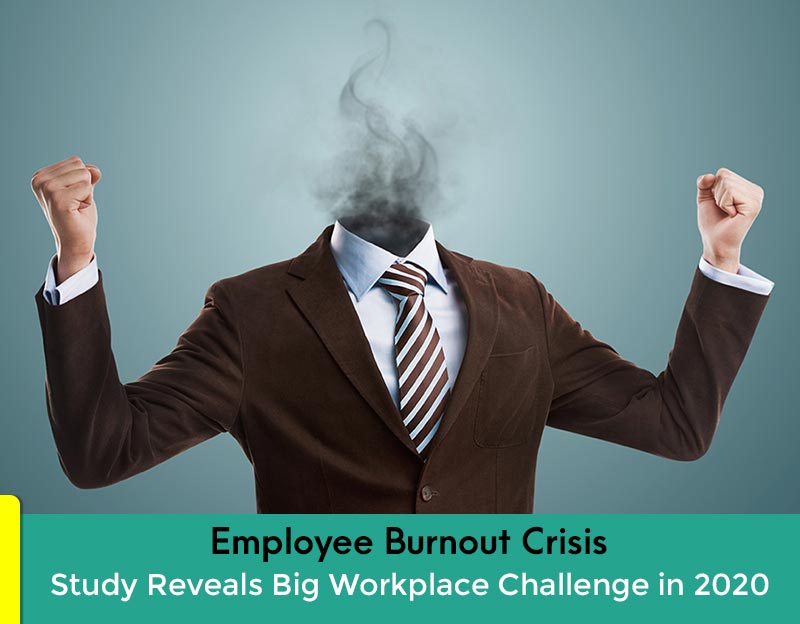Alongside the health crisis we are experiencing in 2020, the marketplace is facing yet another global challenge: Employee Burnout Crisis. Nonetheless, this isn’t an issue that violently exploded out of nowhere. It came, apparently, with a warning and has been going on for many years prior to this pandemic. Now more than ever, however, with the arrival of COVID-19, employee burnout has bulged to an alarming rate.
Burnout worsens as COVID-19 intensifies
In escalating numbers, over 3.9 million responses from the 1.1 million employees worldwide in a survey conducted by Glint last March proves this serious threat as a massive trend. This has terrorized the well-being of employees around the globe.
While people are juggling responsibilities and finding ways to keep up with the current world condition, their mental health could be at risk. The demands of their professional life are taking a toll on their personal life. In many ways, the line separating their careers from their personal, everyday sustenance slowly dims. Employees who are caught in this struggle show 4.4 times higher chance to manifest indications of burnout. Those who are inundated by their work duties are affected 2.3 times.
Although several organizations have begun making a stand to fix this, few are taking actions to actually stand up with a durable set of measures. What each workplace needs is a lasting proactive resolution to counteract this prevalent problem.
What happens to a burnout workforce
An organization is built by its employees. However, it can’t run as efficiently as it should be if its workforce is mentally and physically exhausted. It sabotages productivity among employees and slows down retention. Even the most high-performing employees aren’t safe from getting burned out. This may cause them to be absent, or worse, leave the company altogether due to these unresolved concerns propagating burnout in the workplace.

The general effects of burnout among employees
A survey carried out by Kronos Incorporated and Future Workplace in 2016 reveals the views of 614 HR professionals regarding the HR workplace. These were the findings according to the respondents. As the national survey shows, a yearly turnover is a chilling outcome of general burnout, according to 46% of HR leaders. They cited that it is responsible for more than 50% of turnover every twelve months. Moreover, poor retention is another transparent consequence of burnout. However, this has been watered down for many a time. What could be the reason why? Let’s find out.
Factors that hinder HR from enhancing workforce retention
If you think about it, building up retention is a matter of great significance, especially in businesses. But there seems to be a lot of things that compete for the immediate focus on the solution of this issue in 2017. Over the next five years, it has been noted that retention development will become a critical priority, as deemed by 87% of HR leaders.
However, this has been downgraded by other concerns believed to be much more important. Other barriers to enhancing retention in 2017 are the lack of support from the executive alongside lack of vision in the organization. Question is, will things be the same in 2020?

Primary reasons behind employees’ burnout
According to the study, there are three main factors that trigger burnout. 41% of this is unfair compensation, while the other two are unreasonable workload and excessive overtime, both at 32%. Employees are given too much work with lesser pay than they deserve.
Nevertheless, poor management, inability to see a direct link of their position to corporate strategy, as well as a toxic culture in the workplace, are other contributors. A lot of these are in the hands of HR management.
Outdated or insufficient technology has also been a tremendous cause of burnout for HR leaders. This prevents them from achieving maximum productivity. For instance, their resources are too manual that administrative tasks and pressing problems take too long to be attended to. At least 27% of respondents have mentioned that such a scenario is more widespread at particularly larger companies with 2,500 plus employees. With the technology the marketplace has in 2020, things must turn for the better in this aspect.
Though not as obvious as the other contributors, communication has a subtle yet enormous influence on the well-being of an employee. When people strive to become effective communicators, it scales down vagueness in the workplace and fosters perceived control. This, in turn, safeguards employees from being overpowered by the stresses generated by the present-day reality they are facing. Those with managers who lack the clarity in their words are 2.7 times more expected to display language signaling burnout. As for employees who sensed their organization to have poor communication about change, they are 2.1 times more likely to exhibit the same thing.
Critical ways to mitigate burnout
As it should be, both employers and employees are intertwining efforts to prioritize the wellness of their organization’s manpower. From an individual level, the step-by-step undertaking has upgraded to an organizational endeavor. Numerous companies are moving forward with the appropriate course of action to set an example for others. This is a relatively important step for the betterment of the workforce.

Despite that, many are still yet to gain awareness of the ‘Employee Burnout Crisis.’ If you’re a leader who is conscious of this fact, yet you’re quite unsure how to diminish the hassles of burnout, here’s what you can do for your organization.
1. Have the workforce analytics monitor signs of burnout
An organization cannot just act on the problem individually. It has to be done as a whole. What reasons could there be to this pervasive issue? The company must answer this kind of question to properly construct a firm and effective approach. Hence, when employees are showing frequent absenteeism, this shouldn’t go unnoticed. Such a tendency could have an underlying cause, which couldn’t be impossibly classified as burnout.
2. Spark up a meaningful and engaging discourse
Managers can give support to their employees through the smallest acts. In fact, as simple as a discussion may sound, it’s not simple at all. Exchanging words that carry positivity, sympathy, and encouragement create a ripple effect that reaches as many employees. This makes them feel supported, cared for, and connected.
It need hardly be said but managers can be a great instrument for this meaningful interaction. In return, organizations can aid managers by providing them with factual information and well-divided resources. This approach ensures that individual challenges are based on truth and met with accuracy. As an upshot, managers can likewise open up about their learnings and apply these to their subordinates. All these can enlighten you as a leader and better direct your conduct in the company.
3. Prevent employees from extreme after-work hours
Pouring down unmanageable workload is a classic agent of burnout which, unfortunately, many organizations practice. Employees work for longer hours than intended with too little pay. As a leader, you have to be adherent to the word you swore and do what’s right. When certain injustices take place in the workplace, you have to put an end to these and exercise your power.
4. Initiate on checking employees’ wellbeing
Organizing pulses from time to time helps you keep track of your employees’ welfare. Through this, you can better understand their needs and respond to these with the best action. The mere act of checking in with them is a statement of your organization’s concern as well as drive for productivity.
A commendable example is the case of a person who, inspired by the leadership of Gint, delivered a companywide wellness survey every week. The fact that employees were looking for wellness and mental health support would never have been discovered if not for this thoughtful act. Because of this, the company gave access to its people a global emotional support app that alleviates anxiety, battles stress, and prevents depression.
5. Elaborate priorities and act on them
Considering the role you have, it is of extreme importance to lay stress on prioritization. Constantly de-prioritize issues and activities. But enumerating these priorities is not enough. You have to deliver results. If not, it will just be the same as the survey that took place in 2017 in which workforce retention was set aside by other concerns. Hence, act on the most pressing matter present before you. At this challenging point in history, the mental, emotional, and physical condition of your employees are on top of the list. In an equal regard, you have to look after your welfare, too.
Conclusion
While the Employee Burnout Crisis can’t be extinguished overnight, there are solid strategies organizations can start adopting to reduce its effects. Above all, working conditions must be improved to either hold off this dilemma if it is happening or prevent its outset, if it isn’t. At any rate, leaders of any company can’t just stop and say ‘one crisis at a time.’ Unfortunately, the world is facing two. With burnout employees and a pandemic, we should optimize our resources and delay no more.




